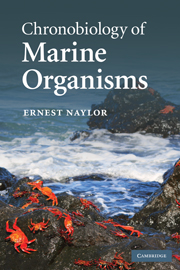Book contents
- Frontmatter
- Contents
- Preface
- 1 Moonshine
- 2 Biorhythms of coastal organisms
- 3 Tidal and daily time-cues
- 4 Clocks and compasses
- 5 Lunar and semilunar biorhythms
- 6 Annual biorhythms
- 7 Plankton vertical migration rhythms
- 8 Staying put in estuaries
- 9 Ocean drifters
- 10 Living clockwork
- References
- Author index
- Subject index
- Plate section
5 - Lunar and semilunar biorhythms
Published online by Cambridge University Press: 05 June 2012
- Frontmatter
- Contents
- Preface
- 1 Moonshine
- 2 Biorhythms of coastal organisms
- 3 Tidal and daily time-cues
- 4 Clocks and compasses
- 5 Lunar and semilunar biorhythms
- 6 Annual biorhythms
- 7 Plankton vertical migration rhythms
- 8 Staying put in estuaries
- 9 Ocean drifters
- 10 Living clockwork
- References
- Author index
- Subject index
- Plate section
Summary
…our natural satellite regulates the life (on earth), through the stability of the terrestrial rotation axis, through the tides, and perhaps through other subtler effects that still need to be better understood.
Cesare Barbieri, 2001Life on earth probably dates back at least 3500 million years. That would have been about 1100 million years after the earth was formed at the time of the origin of our solar system, thought to be about 4600 million years ago, another 5000 million years or more after the ‘Big Bang’ singularity at the beginning of the universe (Hawking, 1988). As the original earth cooled and its rock crust began to form, the moon was created by a process now widely accepted as the ‘Big Splash’ (Benn, 2001). Over 4000 million years ago, some say as little as 30 million years after the earth was formed, it is thought that the proto-earth was impacted by a cosmic object called a planetesimal of about the size of the planet Mars. Impacts of cosmic matter on the earth's surface, in the form of asteroids, comets and meteorites, have occurred many times in geological history, but none could have had such an impact on earth as a lump of matter at least one tenth of the size of earth itself.
Much later another highly significant impact event occurred at the end of the Cretaceous Period, a mere 65 million years ago.
- Type
- Chapter
- Information
- Chronobiology of Marine Organisms , pp. 89 - 115Publisher: Cambridge University PressPrint publication year: 2010
- 2
- Cited by

